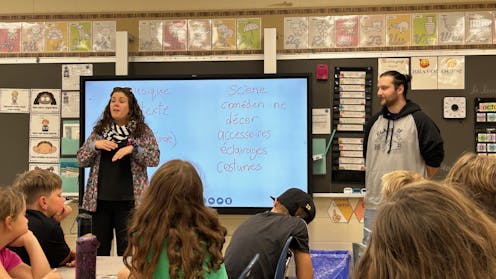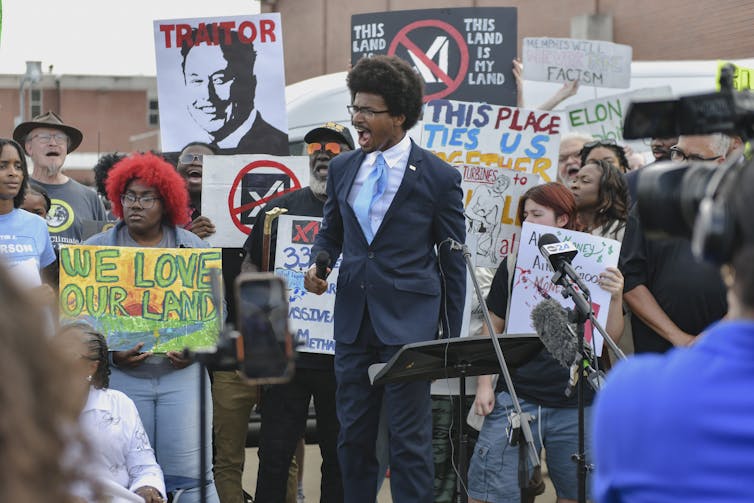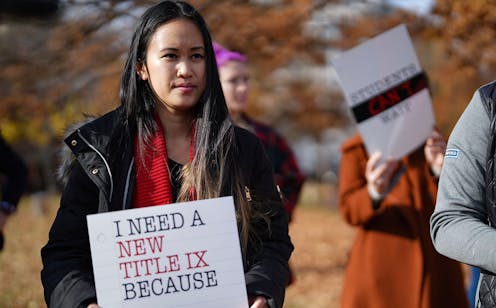Source: The Conversation – France in French (3) – By Diana Mangalagiu, Professeur, environnement, stratégie, prospective, Neoma Business School
Le Pacte vert, supposé guider l’UE vers le net zéro, est aujourd’hui freiné par des résistances nationales : la transition écologique peut y être politisée pour servir toutes sortes d’intérêts. C’est particulièrement le cas en Europe de l’Est, où les clivages idéologiques et le contexte socio-économique jouent un rôle clé. C’est ce que montrent les exemples croisés de la Pologne, de la Hongrie et de la Roumanie.
Il devait s’agir de la boussole climatique de l’Union européenne. Le Pacte vert, adopté en 2019, se heurte aujourd’hui à des résistances nationales qui compliquent sa mise en œuvre. Là où l’Allemagne et l’Italie demandent des aménagements en invoquant des raisons économiques, la Pologne, la Hongrie et la Roumanie montrent comment la transition écologique peut être politisée pour servir toutes sortes d’intérêts, entre dépendance aux énergies fossiles, calculs populistes et consensus souvent fragiles.
Depuis son adoption en 2019, le Pacte vert européen s’est imposé comme la feuille de route de l’Union européenne pour atteindre la neutralité carbone à l’horizon 2050. Il vise à transformer l’économie européenne en réduisant drastiquement les émissions de gaz à effet de serre et en favorisant une transition la plus juste et inclusive possible.
Mais la mise en œuvre du Pacte vert se heurte à de fortes résistances dans bon nombre d’États membres. L’Allemagne, par exemple, défend la nécessité de maintenir des subventions massives à l’industrie et réclame un assouplissement des règles européennes sur les aides d’État pour soutenir la transition industrielle.
L’Italie, elle, s’oppose à certaines mesures jugées trop contraignantes et souhaite « corriger » la trajectoire du Pacte vert, insistant sur la nécessité de disposer d’investissements et de ressources suffisantes pour accompagner la transition, mais sans sacrifier sa croissance économique.
Enfin, les pays d’Europe centrale et de l’Est dépendent plus fortement des énergies fossiles d’un point de vue historique, ce qui peut nourrir des enjeux socio-économiques particuliers. Le Pacte vert peut y être d’autant plus instrumentalisé au plan politique. Dans ce contexte, notre recherche récente apporte un éclairage inédit sur les mécanismes politiques qui sous-tendent l’adoption et la mise en œuvre du Pacte vert dans trois pays d’Europe centrale et de l’Est : la Pologne, la Hongrie et la Roumanie.
Nous montrons que la politisation de la question climatique – c’est-à-dire le fait d’en faire un enjeu partisan – joue un rôle clé dans la façon dont ces pays s’approprient – ou non – les objectifs du Pacte vert. Les clivages idéologiques et le contexte socio-économique ont un impact majeur sur la construction des politiques climatiques nationales.
Pologne, Hongrie et Roumanie : trois scénarios distincts
En Pologne, le charbon n’est pas seulement une ressource énergétique : il incarne un héritage industriel et une identité régionale, notamment en Silésie.
Lors des élections législatives de 2019, la transition climatique s’est imposée comme enjeu central, polarisant la scène politique. Le parti de droite conservatrice Droit et Justice (PiS), qui se trouvait alors au pouvoir depuis quatre ans, a joué la carte du réalisme économique, subordonnant toute ambition écologique à un fort soutien financier de la part de l’UE et à la défense de l’emploi minier. Face à lui, la Plateforme civique (centre droit) et la gauche ont porté des scénarios plus ambitieux de sortie du charbon, mais sans convaincre l’électorat traditionnel : le PiS a conservé sa majorité absolue au Parlement.
Cette polarisation s’est amplifiée avec l’élection, en juin 2025, du président nationaliste Karol Nawrocki, qui se trouve en opposition frontale avec le premier ministre, le pro-européen Donald Tusk (Plateforme civique), à ce poste depuis les législatives houleuses de 2023.
Cette cohabitation complexe freine l’agenda réformateur, y compris sur le climat. Le gouvernement, quoique formé non plus de membres du PiS mais de représentants de la Plateforme civique et de ses alliés de centre et de gauche, réclame désormais une « révision critique » du Pacte vert, accusé d’alourdir les coûts énergétiques et de nuire à la compétitivité. Nawrocki a d’ailleurs promis un référendum sur le Pacte vert.
Malgré tout, la Pologne progresse sur les renouvelables et a réduit ses importations de gaz russe. Elle demeure toutefois loin des objectifs européens.
En Hongrie, la situation est différente. Viktor Orban, premier ministre sans discontinuer depuis 2010, a longtemps utilisé la question climatique pour renforcer sa position souverainiste, ainsi que comme levier dans son bras de fer avec Bruxelles. Lors des négociations sur le Pacte vert, il a menacé d’y opposer son veto, dénonçant une politique « utopique » imposée par l’UE sans tenir compte des réalités nationales.
Pourtant, malgré cette rhétorique, la Hongrie a adopté, sur le papier en tout cas, des plans nationaux relativement ambitieux. Ils visent la neutralité carbone d’ici à 2050 et une réduction de 40 % de ses émissions de gaz à effet de serre d’ici à 2030 par rapport aux niveaux de 1990.
Cette ambivalence est liée à la domination depuis quinze ans de la scène politique hongroise par le parti Fidesz. Maître du calendrier et du discours, Orban politise la question climatique quand cela sert ses intérêts – notamment pour mobiliser contre l’UE – puis désamorce le débat dès qu’il s’agit de négocier des fonds européens ou de répondre à la demande de certains électeurs.
Ainsi, la Hongrie avance à petits pas, en ménageant à la fois Bruxelles et son électorat conservateur. Sans que la question climatique ne devienne un enjeu de division nationale majeure.
À lire aussi :
Viktor Orban, l’homme de Trump en Europe ?
La Roumanie, enfin, offre un troisième scénario. La question climatique y reste largement en dehors de la compétition partisane. Les principaux partis abordent certes les thèmes environnementaux dans leurs programmes, mais sans en faire un enjeu de débat ou de clivage électoral.
Cette faible politisation s’explique par une dépendance énergétique moins marquée que dans les pays précédents et par un certain consensus sur la nécessité de moderniser l’économie.
La Roumanie affiche un soutien de principe au Pacte vert et à la neutralité carbone d’ici à 2050, avec des objectifs nationaux ambitieux : réduction de 85 % des émissions de gaz à effet de serre d’ici à 2030 par rapport au niveau de 1990.
Cependant, malgré des avancées sur les énergies renouvelables, les mesures concrètes tardent à être mises en place, la priorité étant donnée à la modernisation des infrastructures et des services publics. Le gouvernement met en avant la nécessité de concilier croissance économique et durabilité, tout en soulignant le coût élevé de la transition.
À lire aussi :
Percée de l’extrême droite pro-russe, élections annulées… La Roumanie en pleine ébullition
Des divisions nourries par les partis populistes
Nos recherches montrent que dans ces trois pays, la politisation de la question climatique dépend de l’idéologie dominante dans la société, du contexte économique et du poids des industries fossiles et de la structure du système des partis politiques.
-
En Pologne, la forte polarisation et l’attachement identitaire au charbon favorisent une politisation intense qui freine la transition.
-
En Hongrie, la domination d’un parti unique permet une gestion opportuniste de la question climatique, avec des avancées ponctuelles, mais peu de débat public.
-
En Roumanie enfin, l’absence de clivage fort sur le climat permet un certain soutien, mais sans dynamique de transformation profonde.
Pour arriver à ces conclusions, nous avons d’abord passé au crible les engagements climatiques de ces trois pays, leurs plans nationaux énergie-climat (NECP) ainsi que l’évaluation de ces plans réalisée par la Commission européenne. Puis nous avons retracé l’évolution des discours des partis politiques et des débats de société sur le changement climatique et le Pacte vert. L’enjeu était de déterminer l’influence de paramètres tels l’idéologie, la dépendance aux énergies fossiles et le contexte économique sur la politisation du climat par les partis politiques et le gouvernement.
Nous mettons ainsi en lumière le rôle des partis populistes, en particulier de droite, dans la politisation de la transition climatique.
-
En Pologne et en Hongrie, ces partis utilisent la question climatique pour nourrir une rhétorique souverainiste et anti-européenne, accusant Bruxelles d’imposer des sacrifices économiques au nom de l’environnement. Cette instrumentalisation complique la construction d’un consensus national sur la transition et alimente la défiance envers les politiques européennes.
-
En Roumanie, la moindre polarisation du débat politique sur les questions climatiques facilite une approche plus pragmatique, mais au prix d’une mobilisation citoyenne limitée et d’une faible pression pour accélérer la transition.
À lire aussi :
Comment l’autoritarisme a gagné du terrain en Europe centrale
Mais les facteurs structurels (dépendance aux énergies fossiles, niveau de développement, inégalités) n’expliquent pas tout : ce sont les dynamiques politiques, la capacité des partis à s’approprier ou à dépolitiser la question climatique, et la manière dont les leaders utilisent le climat dans la compétition électorale qui font la différence dans la mise en œuvre du Pacte vert.
Il faut également noter que la politisation n’est pas toujours négative. Elle peut aussi permettre de rendre visibles les enjeux climatiques et de mobiliser la société, à condition d’éviter la caricature et la polarisation excessive.
A noter, enfin, que ces trois pays dépendent historiquement de la Russie pour leur approvisionnement en gaz et pétrole. Or, le premier ministre hongrois Viktor Orban se distingue par une connivence certaine avec la Russie tandis que la Pologne et la Roumanie s’en distancient.
Comment éviter l’instrumentalisation du Pacte vert ?
Que retenir de notre étude ? Pour éviter que le Pacte vert ne soit instrumentalisé par les populistes, il est essentiel que les citoyens puissent mieux cerner ses bénéfices concrets : création d’emplois dans les secteurs verts, réduction de la pollution, amélioration du cadre de vie, etc.
L’implémentation du Pacte vert doit donc insister sur la justice sociale de la transition, en garantissant un accompagnement des territoires et des personnes les plus exposées. Il s’agit aussi de valoriser les succès locaux et les initiatives citoyennes, pour montrer que la transition est possible et bénéfique à tous.
Il faut également renforcer le dialogue entre les institutions européennes, les gouvernements nationaux et la société civile, afin de co-construire des politiques adaptées aux réalités locales.
Cela peut passer, par exemple, par la mise en place de budgets participatifs pour les projets « verts » ou par des appels à projets ouverts à la société civile. L’idée est de pouvoir allouer des financements directement à des initiatives locales alignées avec les objectifs du Pacte vert. Cela implique le soutien des acteurs locaux (municipalités, ONG, acteurs économiques, etc.) avec des relais aux échelles nationale et européenne pour faciliter la concertation transfrontalière, l’échange de bonnes pratiques et la remontée structurée des besoins au niveau national et européen.
Une dépolitisation excessive est donc loin d’être la solution : il s’agit plutôt de favoriser un débat public éclairé, fondé sur la transparence, la participation et l’écoute des préoccupations sociales. De quoi aider l’Europe à surmonter les résistances et mobiliser le Pacte vert comme un projet collectif.
![]()
Diana Mangalagiu et ses co-auteurs ont reçu des financements européens pour le projet TIPPING+, un projet Horizon 2020.
– ref. Comment le Pacte vert est instrumentalisé par les populistes en Europe centrale et de l’Est – https://theconversation.com/comment-le-pacte-vert-est-instrumentalise-par-les-populistes-en-europe-centrale-et-de-lest-263960


















